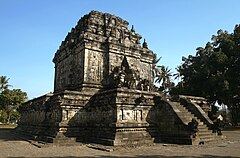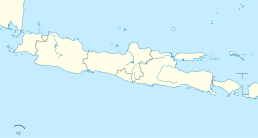Mendut
| Mendut | |
|---|---|
 |
|
|
Location within Java
|
|
| General information | |
| Architectural style | Buddhist candi |
| Town or city | near Magelang, Central Java |
| Country | Indonesia |
| Coordinates | 7°36′20″S 110°13′44″E / 7.6055°S 110.229°E |
| Completed | circa early 9th century |
| Client | Sailendra |
Mendut is a ninth-century Buddhist temple, located in Mendut village, Mungkid sub-district, Magelang Regency, Central Java, Indonesia. The temple is located about three kilometres east from Borobudur. Mendut, Borobudur and Pawon, all of which are Buddhist temples, are located in one straight line. There is a mutual religious relationship between the three temples, although the exact ritual process is unknown.
Built around early ninth century AD, Mendut is the oldest of the three temples including Pawon and Borobudur. The Karangtengah inscription, the temple was built and finished during the reign of King Indra of Sailendra dynasty. The inscription dated 824 AD mentioned that King Indra of Sailendra has built a sacred building named Venuvana which means "bamboo forest". Dutch archaeologist JG de Casparis has connected the temple mentioned in Karangtengah inscription with Mendut temple.
In 1836 it was discovered as a ruins covered with bushes. The restoration of this temple was started in 1897 and was finished in 1925. Some archaeologists who had conducted research on this temple were JG de Casparis, Theodoor van Erp, and Arisatya Yogaswara.
The plan of temple's base is square, and measures 13.7 metre on each side, with the base level 3.7 metre above the ground . The 26.4 metre tall temple is facing northwest. The stairs projecting from the northwest side square elevated base is adorned with Makara statue on each sides, the side of the stairwall carved with bas-relief of Jataka fable narrating the animal story of Buddhist teaching. The square terrace surrounding the body of the temple was meant for pradakshina or circumambulating ritual, walking clockwise around the temple. The outer walls is adorned with bas-reliefs of Boddhisattvas (Buddhist divinities), such as Avalokitesvara, Maitreya, Cunda, Ksitigarbha, Samantabhadra, Mahakarunika Avalokitesvara, Vajrapani, Manjusri, Akasagarbha, and Boddhisattvadevi Prajnaparamita among other buddhist figures. Originally the temple had two chambers, a small chamber in the front, and the large main chamber in the center. The roof and some parts of the front chamber walls are missing. The uppermost part of the roof is missing, it supposed to have a stupa pinnacle with size and style probably just like the one in Sojiwan temple. The inner wall of front chamber is adorned with bas-relief of Hariti surrounds by children, Atavaka on the other side, Kalpataru, also groups of devatas divinities flying in heaven.
...
Wikipedia

